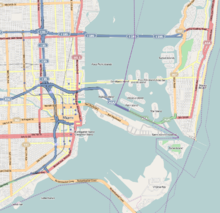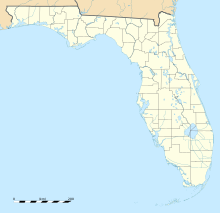Phillip and Patricia Frost Museum of Science
 | |
 Location within Central Miami | |
| Established | 1949 (as the Junior Museum of Miami) |
|---|---|
| Location | Museum Park, Miami, Florida, US |
| Coordinates | 25°47′05″N 80°11′19″W / 25.7846809°N 80.1886406°W |
| Type | Science museum |
| Accreditation | AAM, ASTC |
| Visitors | Estimated 700,000 per year[citation needed] |
| President | Frank Steslow (2017) |
| Public transit access | Metromover access at Museum Park Station |
| Website | Phillip and Patricia Frost Museum of Science |
The Phillip and Patricia Frost Museum of Science (formerly known as the Miami Science Museum) is a science museum, planetarium, and aquarium located in Miami, Florida, US. Originally located in Coconut Grove, the museum relocated to Museum Park in the downtown area adjacent to the Perez Art Museum Miami in 2017.
History[]
The Junior League of Miami opened the Junior Museum of Miami in 1950.[1][2] It was located inside a house on the corner of Biscayne Boulevard and 26th Street. Women of the Junior League started it with little seed money and lots of volunteer hours.[2] The exhibits were made up of donated items, such as a hive of live honeybees which hung outside a window, and loaned materials, such as Seminole artifacts from the University of Florida.[1] In 1952, the museum relocated to a larger space in the Miami Women's Club building on North Bayshore Drive. At that time it was renamed Museum of Science and Natural History.[3]
In 1953, the Guild of the Museum of Science was formed, adding volunteers to assist the staff, run the museum store, and conduct tours and outreach programs.
In 1960, Miami-Dade County built a new 48,000 sq ft (4,500 m2) museum building on a 3-acre (12,000 m2) site in an area of Miami called Coconut Grove.[3] In 1966, the Space Transit Planetarium was added with a Spitz Model B Space Transit Projector.[4] The projector was the last (of 12) of its type that was built, and the last one still in operation in 2015.[5] The Planetarium was the home of the national astronomy show Star Gazers with Jack Horkheimer.[6]
In 2011, the museum launched and hosted the annual Miami Underwater Festival, in partnership with the French Festival Mondiale de l’Image Sous-Marines (World Festival of Underwater Images). The festival was founded and sponsored by underwater photographer Marko Dimitrijevic and his wife, Shelly.[7][8]
The museum and planetarium closed in 2015 in advance of the opening of the new museum. The dismantled Spitz projector is a permanent display piece in the new Frost Planetarium that opened in 2017 (see below).[9]
Closing of Coconut Grove and relocation to downtown Miami[]
In March 2011, Miami native Phillip Frost and his wife, Patricia, donated $35 million to the construction of a new science museum in Downtown Miami.[10] The museum was designed by the New York studio of global firm Grimshaw Architects; Miami's Rodriguez & Quiroga Architects Chartered played an executive role.[11]
The new 250,000 sq ft (23,000 m2) Philip and Patricia Frost Museum of Science opened on May 8, 2017 in Museum Park in downtown Miami.[12][13] The new museum includes: the Frost Planetarium, a 250-seat full-dome screen with a diameter of 67 feet (20 m) and a 16-million-color, 8K projection system;[14][15] a three-story, cone-shaped, 500,000-US-gallon (1,900,000 L) aquarium with a 31-foot (9.4 m) diameter oculus lens at the bottom for viewing the fish, rays and sharks;[13][16] and the Knight Learning Center with four classrooms.[13]
Exhibits[]
Aquarium[]
The museum features an expansive multi-level aquarium featuring the beautiful watery worlds of South Florida and its inhabitants. The top deck of the Aquarium puts you at the surface of key South Florida ecosystems, including the Gulf Stream, brought to life in the sweeping, 100-foot wide, 500,000-gallon Gulf Stream Aquarium, where mahi-mahi, devil rays, hammerhead sharks and much more travel through open water. Nearby, explore the vastly different worlds of coral reefs, mangroves, beaches, and the Everglades. The middle level features underwater worlds: coral reefs, ocean currents mangrove forests, and the Gulf Stream. nearly 30 aquariums and interactive vessels invite you to experience the extreme diversity of the subtropical sea through intimate observation and learning. The bottom-most level exhibits the vast depths of the Gulf Stream. where drifters such as jellyfish ride the massive flow running along Florida's east coast and into the North Atlantic. The aquarium culminates on this floor with a 31-foot oculus lens forming the bottom of the gulf stream aquarium.
Planetarium[]
The 250-seat Frost Planetarium uses 16-million-color 8K projection, surround sound, and a vast dome screen to take you on dazzling visual odysseys to outer space.
Power of Science[]
The Power of Science exhibits the achievements of scientists and researchers past, while also exhibiting the science of the future. The exhibit hosts a series of hands-on exhibits, cutting-edge interactives, rare specimens, an interactive floor, a deep dive into the periodic table of elements, a showcase of collection pieces and scientific instruments used across various scientific fields, and more. Explore the scientific process by asking questions, gaining insight, and persevering through challenges, as you strive to reach a powerful new understanding about ourselves and our world. The exhibit hones in on four realms of science: the oceans, the environment, the human body, and the universe.
Solar System and Beyond[]
Solar System and Beyond showcases over 20 stunning photos and artist renderings of celestial objects by NASA.
Feathers to the Stars[]
Feathers to the Stars carries you through the amazing story of flight from animals utilizing their almost perfect anatomy, to humans using imagination and engineering to get airborne and how outer space is the next frontier.
River of Grass[]
The River of Grass is a sensory-filled journey celebrating the Everglades. Primarily for children, this exhibit carries guests through two related spaces: an outdoor hands-on area, and a hi-tech, indoor virtual Everglades where animal characters frolic and interact, expressing a fun storyline of biodiversity.
The Sun Spot[]
The Sun is a dynamic, powerful source of energy—it's the most abundant renewable resource available on Earth. Modern technology can harness this energy for a variety of uses, including generating electricity through the use of solar power. This exhibition has six different exhibits showing different applications for solar power and different methods of utilizing it.
See also[]
References[]
- ^ Jump up to: a b Murrell, Muriel V. (2003). Miami, a Backward Glance. Pineapple Press Inc. pp. 121–124. ISBN 978-1-56164-286-1.
- ^ Jump up to: a b "Our History – Junior League of Miami". Retrieved 2021-04-24.
- ^ Jump up to: a b "Resolution approving issuance of industrial development revenue bonds for the Museum of Science Inc., also known as the Patricia and Phillip Frost Museum of Science Project by Miami-Dade County Industrial Development Authority" (PDF). Miamidade.gov. April 5, 2016. p. 8. Retrieved June 9, 2017.
- ^ Teproff, Carli (August 30, 2015). "Miami science museum closes after 5 decades before move downtown". miamiherald. Retrieved June 9, 2017.
- ^ Alan Gomez (February 19, 2015). "Miami's fallen star: Planetarium fades to black". USA Today. Retrieved June 9, 2017.
- ^ Emma Brown (August 24, 2010). "Jack Horkheimer, 72, 'Star Gazer' and host of public TV astronomy show, dies". The Washington Post. Retrieved June 9, 2017.
- ^ Ross, Duree (2011-05-25). "Miami Science Museum to host first Miami Underwater Festival". Miami's Community News. Retrieved 2020-12-29.
- ^ Duree&co (2015-06-10). "Patricia and Phillip Frost Museum of Science Explores the Sea's Mysteries with the 4th Annual Miami Underwater Festival". Durée & Company. Retrieved 2020-12-29.
- ^ Sayre, Wilson (August 29, 2015). "The 1960s projector at Miami's planetarium will retire with the closing of the museum's old location". miamiherald. Retrieved June 9, 2017.
- ^ "Miami Science Museum Receives $35 Million for New Building". Philanthropy News Digest (PND). March 29, 2011. Retrieved June 9, 2017.
- ^ Viglucci, Andres (May 4, 2017). "Planets soar. Sharks swarm. Lasers sparkle. Humans rejoice. The Frost Science museum will finally open". miamiherald. Retrieved June 9, 2017.
- ^ Kendall, Jonathan (8 May 2017). "The Frost Science Museum Finally Opened Today, and It Was Worth the Wait". Miami New Times. Retrieved June 9, 2017.
- ^ Jump up to: a b c Carolyn Guniss (May 3, 2017). "Science museum to be unveiled in Miami". Miamitimesonline.com. Retrieved June 9, 2017.
- ^ "Sky-Skan is to Power Miami's New Frost Planetarium". Fulldome Database - FDDB.org. 17 August 2016. Retrieved June 9, 2017.
- ^ "Technology - Frost Science". Frost Science. Retrieved June 9, 2017.
- ^ "Aquarium - Frost Science". Frost Science. Retrieved June 9, 2017.
External links[]
- Museums in Miami
- Planetaria in the United States
- Coconut Grove (Miami)
- Science museums in Florida
- Natural history museums in Florida
- Museums established in 1949
- 1949 establishments in Florida
- Aquaria in Florida


